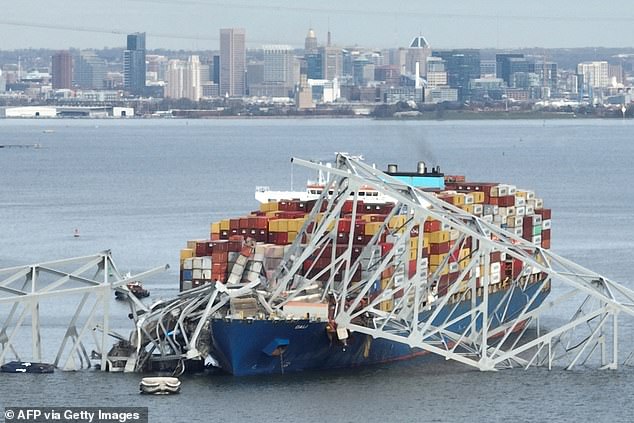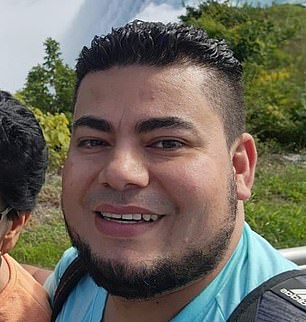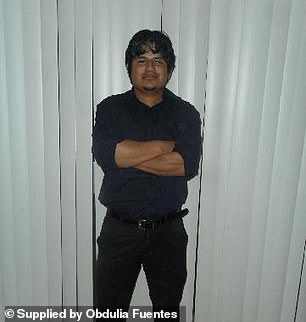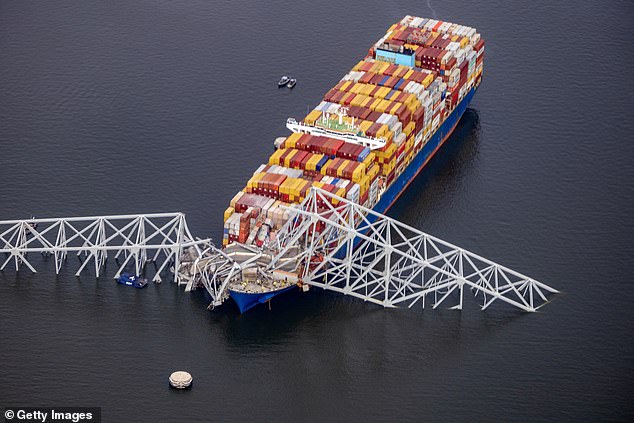The city of Baltimore is suing the owner and operator of the ship that crashed into the Francis Scott Key Bridge last month, alleging the ship was “unseaworthy” when it left port.
The 985-foot Dali ship was manned by “an incompetent crew” and set sail despite several prior warnings about its safety, the lawsuit claims.
Six workers on a construction crew died in the accident, which paralyzed one of the busiest ports in the United States.
In court papers filed Monday, city officials, including Mayor Brandon Scott, say the ship’s parent company, Grace Ocean Private Ltd, and its operator, Synergy Marine Group, were “potentially criminally negligent.”
The city claims the ship sailed despite “alarms showing inconsistent power supply” and accuses the ship’s owner of supplying it with “unseaworthy equipment, systems and accessories.”
The city of Baltimore is suing the owner and operator of the ship that crashed into the Francis Scott Key Bridge last month, alleging the ship was “unseaworthy” when it left port.

Mayor Brandon Scott is seeking substantial but unspecified damages that could total more than $40 million to replace the bridge and cover the cost of the port’s disruption.
It also alleges that the 21-man crew, 20 of whom were Indian citizens, lacked adequate skills and training and “failed to comply with local navigation customs.”
The ship had been flown by specialized local pilots trained to avoid obstacles in ports.
The ship is believed to have lost power after leaving its port, causing it to veer off course and crash into a column supporting the bridge, although a formal report on the causes has not yet been completed.
“None of this should have happened,” the city’s lawsuit says. ‘Reports indicate that even before leaving port, alarms had been raised showing inconsistent power supply on the Dali. The Dalí left the port anyway, even though it was evident that she was not seaworthy.
The claim adds that an onboard backup generator was not powerful enough to regain control of the ship after it lost power at 1:24 a.m., meaning it hit the bridge at approximately 7 knots.
Baltimore is seeking significant but unspecified damages to pay for bridge replacement, port closure costs and increased spending on utility workers, among other costs.
“The city is pursuing its legal claims against those responsible for the Key Bridge disaster to ensure that the city, its residents and its businesses are appropriately compensated for their losses,” the Baltimore City Law Office said in a statement.
A spokesperson for Grace Ocean and Synergy said it would be inappropriate to comment while the U.S. Coast Guard and FBI were still investigating the accident.
Both companies filed a petition April 1 in federal court in Maryland to limit their liability to $42.5 million.
The petition cites a pre-Civil War protection that means its liability can be limited to the value of the ship’s wreckage after a casualty.
He also categorically denied any wrongdoing on his part in the incident.
‘The discharge was not due to any fault, negligence or lack of care on the part of the petitioners. [Grace Ocean and Synergy]”, the vessel, or any person or entity for whose acts the petitioners may be responsible,” the document says.
Mayor Scott has opposed any cap and the city will likely seek damages significantly higher than $42.5 million.
The lawsuit will be decided by a federal court in Maryland.

The 985-foot Dali ship was manned by “an incompetent crew” and set sail despite several prior warnings about its safety, the lawsuit claims.

Six construction workers who fell into the river when the Francis Scott Key Bridge collapsed are presumed dead as the Coast Guard calls for a search.
Last week, the FBI launched a criminal investigation to determine whether any of the crew members, who remain on board, knew of serious problems with the Dali before setting sail.
The National Transportation Safety Board is also conducting its own investigation into the cause of the crash.
The early stages of the investigation focus on the electrical power system of the massive container ship that veered off course.
Investigators are also examining the design of the bridge and how it could be built with better protection of the pier.
Salvage crews continue to remove sections of the fallen bridge, including those tangled in a muddy mess at the bottom of the Patapsco River.
Officials said they still hope to open a third temporary shipping channel in late April, allowing significantly more commercial traffic to pass through the Port of Baltimore. The east coast maritime hub has been closed to most shipping traffic since the bridge collapse, which blocked access to its main channel.
Joe Biden called on the federal government to pay the full cost of rebuilding the bridge and gave the green light to Maryland’s request for $60 million to aid initial recovery efforts.


Miguel Luna (left), 49, from Guatemala and Alejandro Hernández Fuentes (right), 36, from Mexico, were two of six construction crews who died after the container crashed into the Baltimore Bridge in the who were working in the early hours of March. 26
The six men who died in the accident were part of a construction team from Central and South America repairing potholes in the bridge.
The distraught mother of Alejandro Hernández Fuentes, 36, whose body was found inside a red van that had sunk 25 feet into the river, told DailyMail.com she wished she had told him how much she loved him the last time they spoke.
Obduelia Fuentes said her son, a father of four, followed her to the United States from Mexico in 2006 because “he couldn’t stand being without his mother.”
His body was taken out of the truck along with that of Dorlian Ronial Castillo Cabrera, 26 years old, from Guatemala.
Miguel Luna, 49, and José Mynor López, 35, also from Guatemala, Maynor Suazo, 37, from Honduras, and Carlos Hernández, from Mexico, were the other victims.


